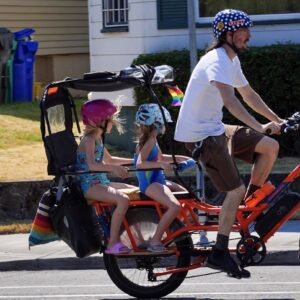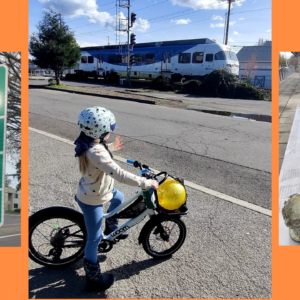
(Photo © Todd Boulanger)
Almost since the day it opened, TriMet’s WES commuter rail faced questions from riders about a lack of bike capacity. Now comes word that TriMet has purchased two retired, vintage (1955) Alaskan Railroad “rail diesel cars” (RDCs) to supplement existing WES trains.
The interior configuration of these RDCs — a split layout for passengers and luggage — makes the possibility of a bike car feasible.
Today, each WES car has room for six bicycles (two on hooks, and room for four in priority seating areas), but our transit expert (and former transportation planner with the City of Vancouver) Todd Boulanger says the new railcars offer TriMet an opportunity to carry up to 32 bikes.
Boulanger has ridden on Caltrain’s ‘bicycle trains’ in California. Those railcars have a similar configuration as TriMet’s new RDCs. Here’s more from Boulanger:
“There is an opportunity for TriMet to introduce a Caltrain-style bike portage service to their WES line if they choose to… The Caltrain carriages have a split layout that allows them to carry from 32 to 40 bikes in addition to passengers. The Alaskan 702 unit [which TriMet purchased and can be seen here] could easily and affordable carry a large number of bikes in a similar configuration, as it is a converted combined baggage and carriage car (about 70 passengers). The bike portage layout could also allow for enhanced ADA access.”
BikePortland West side correspondent Jim Parsons says he was told by a WES operator saying the new RDCs would be used to increase bike/ADA capacity.
What does TriMet say? Planner Colin Maher confirmed with us that they’ve purchased the new cars, and says the RDCs have baggage areas “that could be used for bicycles”. Maher says the two new RDCs will run together as a single train and will only be used “as a spare train”. He stopped short of making any bike car promises.
“Like the regular WES trains, the spare train will have space for bicycles, but until they arrive it’s too early to say how the space will be configured.”
— Lean more about the trains TriMet has purchased here and here. Also read a blog post on The Oregonian for more photos and information about the cars.






Thanks for reading.
BikePortland has served this community with independent community journalism since 2005. We rely on subscriptions from readers like you to survive. Your financial support is vital in keeping this valuable resource alive and well.
Please subscribe today to strengthen and expand our work.
Considering:
a) rapidly increasing use of mobility devices by the general population
b) ever growing number size of the bike riding population
c) Increasing size and complexity of both mobility devices and bicycles
It makes a lot of sense for TriMet to incorporate train cars that have a lot of storage space and are designed to board and deboard mobility devices and bicycles quickly.
As one who has used the bike cars on caltrain, I have to say that the configuration is terrible. As you can see from the picture, the bikes have to be stacked on top of each other and invariably the person who need to to get out next is the one who has their bike against the wall, 3 bikes deep. With a minute to try and get all of your gear off the train, it does not work very smoothly and leads to a lot of scratched bikes. Hopefully Trimet will configure things differently.
This reminded me of something Mayor Adams said last night at the Bicycle Culture reception when asked about why Tri-met was so slow to adding more bike capacity.
“In Europe, bikes aren’t allowed on a lot of rail transit systems, unless their folding bikes, …we are gonna probably have to move to the kind of collapsible bike expectation in this city…”
Kind of a shitty thing to hear at first, but if you think about it, if we succeed in achieving the mode-split goals we’ve set for ourselves, at a certain point trying to add enough transit capacity would be ridiculous.
Amos,
keep in mind that WES is very different than MAX. I agree with the Mayor that TriMet should not worry about adding more bike capacity on MAX lines (we’ve covered that issue at length on this site)… TriMet’s business is moving people, not bicycles.
(the real problem i see is that TriMet does not have enough bike parking at their MAX stops… but that’s another topic).
However, WES is commuter rail and as such I think bike cars and more bike capacity is something that makes more sense.
yesssssssssssssssssssssss
THANK YOU TRIMET!!!!!!!! It’s wonderful to see that our comments about bike capacity haven’t fallen on def ears. Cheers to a larger range multi-modal option for Portlanders!
Increased connective rail transport for bike commuters and bike tourists is certainly a good thing. About the new train units themselves:
Read a little Oregonian article (link below for a different by related article) about the purchase of these cars by Trimet for the WES line. They really are ‘vintage’ units: built in 1955. That’s very old technology (less fuel efficient?), but cheap at $75,000.
The reason stated for the purchase in the article I read and the Rose article below, was not for all the great reasons listed in the Maus article above; increased bike capacity and ADA accessability. They were purchased because the WES cars that Trimet spent tons of money on…are always breaking down. Nice to be able to fall back on the tried and true when the modern stuff can’t cut it.
At any rate, the vintage Budd units are beautiful, and I’m glad to see they have a useful life ahead of them, looking forward to see them running through Beaverton. I’ll bet train buffs are super excited about this latest development. If they’re gonna help more people using bikes for transportation get to where they’re going…all the more better.
TriMet’s new (used) WES trains inside and out/Joseph Rose Oregonian
An optimal configuration would be to have lots of bike parking at the train staions, and of course an easy way to bike there, and a killer bike sharing system in the city. After visiting Paris and trying out the Velib, I’m convinced that myself and lots of other bike owners would use bike sharing if it were convenient.
Before I questioned if a bike owner would ever use bike share. I don’t always have my bike with me and there are plenty of times when I don’t and I would love to use a bike for a quick one-way or round trip. I’m convinced on bike sharing if the system is large enough. Paris has over 1500 bike stations though 🙂
jonathan #4 – “the real problem i see is that TriMet does not have enough bike parking at their MAX stops”
agreed, though i’d add the word “secure”. All the staple racks in the world wouldn’t get me to leave a bike i valued at a MAX stop all day…
You’re right, Jonathan, I didn’t really think about the distinction. My first instinct upon hearing the term “rail transit system” was that it applied to the entire system. Hopefully a different philosophy is applied to commuter rail… in fact, it obviously has been.
Correction plese…
In a conversation with a WES operator, Jim Parsons says he was told that the new RDCs *could* be used to increase bike/ADA capacity.
I wanted to make sure that it’s clear, I wasn’t evesdropping. During the conversation I was told bike capacity could be increased, but not guaranteed.
Aww nuts… plese… I think I need a new keybord (joking)
Nice to see the reuse of old train cars! I don’t think this will have any practical benefit for transit riders with bikes, these are only for use when the more modern trains need servicing.
It is nice to dream though!
Jonathan, a more modern and descriptive term for these cars, instead of “rail diesel car,” is Diesel Multiple Units, or DMU. To transit planners and engineers, this implies that the train cars are self-propelled and use diesel.
The alternate term is Electric Multiple Unit. An example of this is MAX light rail cars.
I think this is really positive news. I hope that TriMet will read this article and everyone’s comments and make this possibility of additional bike storage a reality.
just like CalTrain 🙂 thanks guys!
I read about this in the Oregonian yesterday, but I don’t think anything about a bike car option was mentioned. The article just said the cars would be used as spares, for when other cars are in for mechanical difficulties… so even if they were suped up to be special bicycle cars I don’t know that anyone would be able to count on them being available on any given day.
also open that line up outside the m-f connecting people to Salem :)too
Hi Steven…thanks for the correction.
I had DMU originally in my contribution to the article but I fell back on the older term since I was not sure how they would be configured by Trimet.
So that explains why they bought that piece of junk! For the bicycles!
finally
I would be deeply impressed to see this line carrying bicycles. But they also desperately need to run this service on weekends
I’m for bikes on trains, but bikes take space, and shouldn’t be free. It’s a considerable cost to haul another heavy rail car and uses a bit of fuel. That kills both the economy of the service (operating ratio) and greenness of bikes (hauling a heavy rail car each day). There should be a fee for bikes on trains; many European countries do this, which keeps the bike squeeze reasonable using market forces. To counter, and still allow bikes to be part of the system, massive bicycle lockers should be at every station — save the train space for the bodies. I keep a second, cheap bike at my destination and bike from there to work. There is a cost for the second bike, which is why charging a modest fee for bikes would encourage purchase of a second bike and keep the need for equipment procurement and fuel to a minimum on a modest system like MAX.
Second the motion for fee’s for bikes!
They should have planned a service that could have run at least once an hour and on the weekends. A few trips in the morning and the afternoon does not justify the expense of this friggen thing!
Don’t forget the upset the entire Beaverton Transit Center for a year with this nonsense! And when it breaks down they pull buses off already established routes on the west side!
The WES is a joke, its a failure and should be abandoned!
relentlesscactus and AL M, charging for bikes makes sense for Trimet if they have maximized usage for regular passengers. I haven’t been on the WES, but if the cars aren’t full, then their low variable income isn’t covering their high fixed cost.
If this is the case, Trimet may be better served not charging for bikes so that they can increase usage and cover their fixed cost. First, Trimet needs to ensure that they are maximizing usage, after that, they can figure out to deal with overcrowding due to bicycles.
agree, fees are for when bikes require addition of more cars. Passengers should be aware of the coming change, and encouraged to get a second bike and provided with lockers, much cheaper than more rail equipment for hauling steel and rubber.
#23 –
They should have planned a service that could have run at least once an hour and on the weekends. A few trips in the morning and the afternoon does not justify the expense of this friggen thing!
During the design and planning phase, it was determined that initially the most cost effective service would be for commuters, weekdays during rush-hours. With the planned expansion, weekend service and all day service is expected to occur.
Don’t forget the upset the entire Beaverton Transit Center for a year with this nonsense! And when it breaks down they pull buses off already established routes on the west side!
TriMet doesn’t remove any service when the bus-bridge is needed. They have three buses in Wilsonville and additional buses at Merlo Garage and utilize drivers on standby already. Personally, as a daily user I didn’t experience any issues at the Beaverton TC.
The WES is a joke, its a failure and should be abandoned!
The same could be said for any other form of transportation and be justified in a similar manner. Many people don’t realize that all modes of transportation are subsidized. In comparison of other new rapid/mass transit lines, the cost per mile for WES is close (some estimate even cheaper) than other regional lines.
The savings will be made up with the expansion of the system to Salem (already past planning phase, already requesting federal funding) and other locations. Cost per mile will drop and less subsidy will be needed.